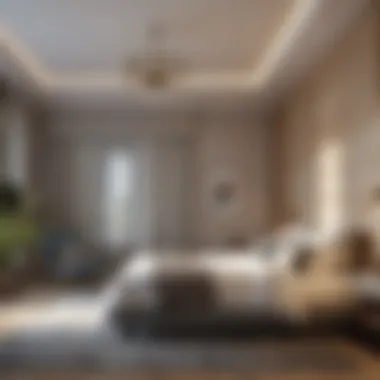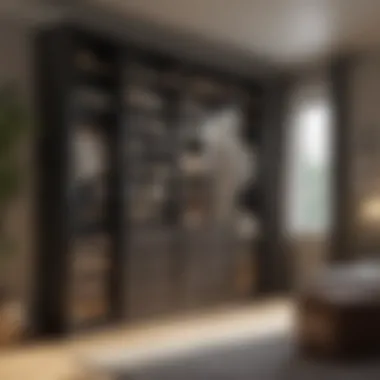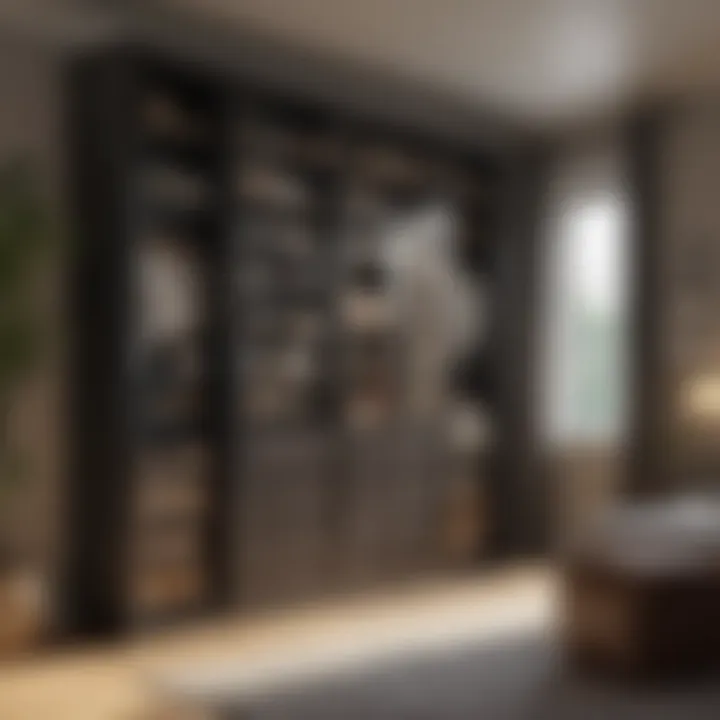Mastering Bedroom Decluttering: A Complete Guide


Intro
In today's fast-paced world, clutter often seems to sneak up on us, turning our once serene bedrooms into chaotic spaces. As housewives and homeowners strive for harmony in their lives, the bedroom serves as a critical sanctuary— a place to recharge and reflect. However, with the hustle of daily routines, belongings can pile up faster than you can say "bedtime."
This guide aims to unpack the art of decluttering your bedroom, revealing not just how to clear out the excess, but also emphasizing the importance of creating a space that mirrors your personal style and offers tranquility. By diving into psychological and practical benefits intertwined with a clutter-free environment, you'll learn actionable strategies to regain control over your space. Here, we don’t just aim for a neat bedroom; we explore how an organized space can uplift your mood and foster productivity.
In the following sections, you will find step-by-step techniques to categorize your belongings, valuable tips for reducing clutter, and creative organizational solutions tailored to fit different lifestyles. Let's embark on this journey towards transforming your bedroom into a peaceful retreat.
Understanding the Importance of Decluttering
Decluttering is more than just a chore; it's a critical step towards establishing a harmonious living environment. The importance of decluttering cannot be overstated, especially in a space as personal as your bedroom. A cluttered bedroom doesn’t just accumulate physical items; it often carries emotional weight, affecting your mood and overall well-being. When your personal space feels chaotic, it can mirror into other areas of your life, creating a constant sense of unease.
Understanding the importance of decluttering starts with recognizing how clutter can seep into our daily lives, disrupting our peace of mind. Many find themselves overwhelmed, unable to focus or relax in a room that feels more like a dumping ground than a sanctuary. Sorting through these belongings can feel daunting. However, it’s essential to see this as a chance for personal growth, triggers for positive change, and a way to reclaim your space.
The Impact of Clutter on Mental Health
Research consistently links clutter with increased stress and anxiety levels. The sight of disarray can be a visual reminder of unfinished tasks or unresolved issues, leading your mind to run in circles. This is especially significant in the bedroom, a retreat meant for rest and rejuvenation. It should be a space that promotes tranquility rather than turmoil.
Think about it: when you walk into a messy room, do you feel at ease? Not likely. Instead, a tidy, organized space can promote a sense of accomplishment, creating a positive mental environment. You may not realize it, but that pile of clothes on the chair may be nagging at the edge of your consciousness, pulling you into a cycle of worry. Clearing your space can bring clarity to your mind, allowing your thoughts to settle.
"Clutter isn’t just a physical presence; it's a mental burden. Clearing out the old can bring in a fresh perspective."
Benefits of a Clutter-Free Bedroom
A clutter-free bedroom is not just aesthetically pleasing but also immensely beneficial for overall well-being. Some of the key advantages include:
- Improved Sleep Quality: A serene environment contributes significantly to better sleep. When your bedroom is organized, it’s easier for your mind to wind down, encouraging a restful night.
- Enhanced Focus: An orderly space fosters productivity. Whether it's reading a book or working on a hobby, having a clutter-free environment allows you to direct your energy towards what truly matters.
- Increased Creativity: A clear mind in a clear space promotes creative thinking. Freeing yourself from distractions can ignite the spark you need to unleash new ideas.
- Better Emotional Health: Many people experience a sense of relief and satisfaction after decluttering. It can be quite liberating to let go of items that no longer serve you, which can boost your mood and energy levels.
In summary, recognizing the importance of decluttering sets the foundation for creating a bedroom that supports your emotional and psychological health, allowing you to thrive in your personal space.
Preparing for Decluttering
Preparing for decluttering is not just a practical step, it’s a fundamental phase that can significantly impact how successful you’ll be in creating a serene environment. It sets the stage for the entire process, allowing you to approach the clutter with a clearer mind and understanding. Diving in without preparation often leads to frustration and half-finished tasks. If you want to make this journey smoother and ultimately more rewarding, getting your head in the right place is key.
When you prepare for decluttering, you are basically giving yourself the advantage of foresight. Taking a moment to think through your goals and priorities keeps you focused and helps navigate any emotional bumpiness that often arises during this process. Clutter can sometimes carry sentimental weight—those old toys or that shirt from a trip you took ten years ago. By preparing mentally beforehand, you’ll be less likely to get sidetracked by nostalgia.
Establishing a Decluttering Mindset
Establishing a decluttering mindset means you’re creating a mental framework that helps you tackle the task ahead. It’s not merely about getting rid of stuff—it's about fostering an environment that aligns with your values and lifestyle. It’s important to remember that decluttering isn't just a one-off event; it’s a mindset that should evolve over time.
Think of your bedroom as a reflection of yourself. If that mirror is foggy and cluttered, it won’t exactly be a clear representation of who you are. Ask yourself what kind of space you want to cultivate. A calming sanctuary? A more functional multi-use area? Understanding your aspirations will give you the drive to sort through what truly matters versus what’s just taking up space.
Start by visualizing how a decluttered room would feel. Picture yourself relaxing in a space that is not just organized but also energizing. This vision will serve as a motivating force when the going gets tough. A simple exercise can be jotting down three words that describe how you want your space to feel. "Calm," "inviting," "organized"—whatever resonates with you.
Setting Clear Objectives
Setting clear objectives lays down the framework for what you intend to achieve. Without clear targets, you may end up wandering aimlessly through your belongings, unable to make decisive choices. Think about it as creating a roadmap. If you don’t pinpoint your destination, chances are you’ll get lost along the way.
A good starting point is to define your end goals. This might include specific areas you aim to declutter—like the closet or bedside table—or perhaps emotional goals like reducing stress. Make the objectives specific and measurable. For instance, rather than saying, "I want to declutter my closet," you might say, "I will sort my closet so that only clothes I frequently wear remain, aiming for at least 50% less hanging items."
Another useful approach is prioritizing the order in which you want to tackle different zones of your bedroom. You could use a simple list or categorize areas by importance. For example:
- High Priority: Nightstand, closet
- Medium Priority: Under-the-bed storage, dresser
- Low Priority: Decorative shelves, desk area
This honesty with yourself will enable you to approach decluttering with clarity and purpose, making you feel less overwhelmed and more in control of your environment.
Remember, decluttering is a pathway to not just a clean bedroom, but also a clearer mind. It's more about quality of life than simply removing items.
Step-by-Step Decluttering Process
The notion of decluttering can feel a bit like climbing a mountain, daunting at first glance. To truly nourish a serene environment, we need a strategic approach. The step-by-step decluttering process is key—it's about breaking the task down into manageable bits that allow for methodical progress. This segmentation not only reduces overwhelm but also provides clear-cut goals that can foster a sense of achievement with each completed stage.
By guiding you through each step, you create a sustainable plan that turns chaos into order, while simultaneously establishing new habits in managing your space afterward. Let’s delve into the mechanics of this process.
Starting with One Area at a Time


Imagine entering your bedroom and feeling the weight of clutter all around. Clothes strewn about, a pile of books gathering dust—yikes! Diving in headfirst might lead to disaster. Instead, the golden rule is to start with a single area.
Focusing on a specific zone, like a drawer or a closet, allows for concentrated effort without overwhelming yourself. You might take one drawer of your nightstand, for example. Sort through the items there. Ask yourself: Do I use this? Does it bring me joy? Once that area is cleared, you’ll feel a refresh. It’s like taking a breath of fresh air after being in a stuffy room.
Moving through different segments gradually creates a ripple effect of motivation. Each small win ignites enthusiasm for the next task, slowly transforming the entire space.
Evaluating Items: Keep, Donate, Discard
This is where the rubber meets the road—deciding which items warrant a spot in your sanctuary. Rather than letting sentiment dictate your choices, having a system in place can help. After you’ve chosen an area and started sorting, create three distinct piles or bags: keep, donate, and discard.
- Keep: This includes everything you use regularly and truly value.
- Donate: If an item is in good condition but you no longer need it, consider giving it a new life through donation.
- Discard: For those items that are broken, expired, or simply dirty—out they go.
It's often suggested to ask yourself some poignant questions to aid in this evaluation. But instead of just going through the motions, try being mindful. For instance, instead of only thinking, "I might use this someday," consider the practicality of it—realistically, when was the last time? This clarity will help you make more decisive choices.
Creating a Plan for Each Category
Once you've sorted through your items, it's time to craft your organizational strategy. Think about it like putting a puzzle together—each piece should fit neatly into the bigger picture of your life.
Start by categorizing what’s left in your keep pile. You might have clothing, sentimental items, accessories, or books. Each category requires its own unique approach:
- Clothing: Organize by season or type; arrange dresses beside skirts and pair shoes with their respective ensembles.
- Books: Consider an option like a favorite cover or genre, making them easy to find. Bookshelves not only display but also contribute to aesthetics.
- Sentimental items: Limit yourself to a few cherished pieces. You may need a dedicated box to avoid overflow. Keeping knick-knacks limits clutter without sacrificing memories.
By scheduling your organization for each category, you sidestep the chaos. It's about creating a vision for your newly decluttered space and following through with practical solutions. Consistency is the name of the game.
"Decluttering isn’t just about what you keep or toss; it's about redefining your relationship with your space."
By embarking on this step-by-step journey, you’re setting the stage for a bedroom that not only looks organized but also feels like a personalized haven. As you progress, remember, it’s not just about letting go of what no longer serves you. It's about building a space that reflects your lifestyle and nurtures your well-being.
Organizational Strategies for a Decluttered Bedroom
Keeping a bedroom clutter-free is not just about tossing out unneeded items; it’s about creating an effective organizational system that suits your life and preferences. A well-organized bedroom fosters serenity and clarity, allowing you to focus on what matters most. When you have a system in place, it allows for smoother daily routines and less time spent searching for misplaced items. This strategy can be particularly valuable for busy individuals, like housewives and homeowners trying to juggle various responsibilities.
Using Storage Solutions Effectively
Storage is a crucial element of any organized room. It’s all about finding the right places to tuck things away so that your space feels open and inviting, rather than cramped and overwhelming. Utilize under-bed storage to make the most of those often-overlooked areas. Boxes or bins can slide easily under your bed to store seasonal clothing or extra linens. This way, you keep everything within reach without cluttering your visual space.
Additionally, consider decorative baskets or containers that not only organize your belongings but also add to the aesthetic of your room. You can place these on shelves or in corners as stylish solutions that blend function with design. Remember, the aim is to make everything accessible without sacrificing style.
Maximizing Vertical Space
When floor space comes at a premium, think upwards. Walls can be your best friend when it comes to organization. Install shelving units above the headboard or around the room to display books, plants or decorative items. This not only draws the eye up, adding a sense of height to the room, but also frees up valuable space below.
In addition, using hooks can turn a wall into a practical storage area. Hang bags, jackets, and accessories on decorative hooks in a way that complements your decor. It’s an unmatched convenience that keeps often-used items accessible yet organized.
Incorporating Multi-Functional Furniture
Multi-functional furniture can be a game changer for those looking to maintain an uncluttered bedroom. Think of a bed with built-in drawers or an ottoman that opens up for storage. These pieces serve multiple purposes, providing seating and decor while also hiding away clutter. It’s the perfect blend of utility and design, maximizing your space.
When shopping, look for items like a desk that can double as a nightstand or a vanity that provides hidden compartments for makeup and accessories. Such selections are particularly useful as they adapt to your needs over time, keeping up with changes in your lifestyle.
Remember that simplicity often holds the key to organization. The fewer items you have, the easier it is to keep them organized.
Incorporating these strategies can profoundly transform your living space. With organized systems in place, every piece has its designated spot, leading to less visual chaos. This in turn creates a tranquil atmosphere that can significantly enhance your quality of life.
Maintaining a Clutter-Free Environment
A clutter-free environment is more than just an aesthetic choice; it can significantly impact overall well-being and productivity. Without a doubt, the state of your bedroom can influence your mood and how you approach your daily tasks. When clutter piles up, it often leads to feelings of stress, distraction, and even anxiety. Therefore, establishing methods to keep that space organized and tidy is invaluable.
Establishing Daily Routines
Creating daily routines helps combat the chaos that can creep in over time. A systematic approach makes the task of maintenance seem less daunting and can be incorporated easily into one’s lifestyle. Think of it as setting the groundwork for a serene space where you can recharge after the demands of the day.
- Designate Time for Tidying Up
Consider allocating a specific time each day—maybe a half hour in the morning or evening—to tidy up your bedroom. This quick session can prevent minor messes from snowballing into major clutter. - Adopt the "One In, One Out" Rule
Whenever you bring something new into your bedroom, consider letting go of something old. This keeps the number of items in the space relatively constant and manageable. - Harness the Power of a Clean-Up Playlist
Sometimes, a little motivation can go a long way. Create a playlist of your favorite tunes to uplift your spirits while you tidy up. It can make a routine feel less like a chore and more like a pleasant part of your day.
With consistent daily commitments, one can uphold a pleasant atmosphere that leads to greater peace of mind.


Periodic Decluttering Sessions
Establishing a habit of daily tidying contributes to a clutter-free environment, but periodic decluttering sessions take that commitment further. These sessions can be set monthly or even seasonally to assess larger items and spaces that may have been overlooked.
- Set Clear Timeframes
Prevent the periodic declutter from feeling overwhelming by setting aside a specific block of time. Whether it's a weekend morning or a weekday evening, having a dedicated time for this task can make it manageable. - Target Different Areas Each Session
Break it down by focusing on one area at a time—perhaps the closet, under the bed, or your nightstand. Each session should have a clear objective, ensuring that every corner of your room gets attention over time. - Involve the Family
If you share the bedroom or live with family, involving them can help distribute the workload and teach cooperative habits. It becomes a shared responsibility that can unite household members in maintaining a serene setting.
"A clutter-free room today paves way for a peaceful mind tomorrow."
Emphasizing these sessions aids in keeping the environment from becoming overwhelming. They also allow for reflection on what items truly add value to your life versus those that don’t serve a purpose anymore.
By focusing on daily routines and periodic decluttering, you pave the path toward a bedroom that not only delights the eyes but also offers a sanctuary for the soul.
Psychological Aspects of Decluttering
The act of decluttering extends beyond mere aesthetics or functionality; it delves into the psychological landscape of our lives. Many might not grasp that the environment we inhabit directly influences our mental well-being. A cluttered bedroom can be akin to a weight pressing down on our shoulders, while a tidy one promotes clarity and peace of mind. This section explores how decluttering can shape our mental states, promote mindfulness, and resonate with our personal values.
The Connection between Order and Peace
Imagine walking into a room filled with chaos: clothes strewn about, books piled haphazardly, and miscellaneous items scattered all over. The overwhelming sensation it induces often extends to our mental state. Clutter can elevate stress levels and create anxiety. In contrast, a well-organized space promotes a sense of order. Simplicity in ones surroundings leads to a feeling of calm, almost like taking a deep breath after being underwater.
When everything is in its place, we are better able to focus. Our brains naturally prefer order to disorder; research shows that organized spaces lead to increased productivity and improved concentration. Creating a serene environment can not only make daily tasks easier but also enhance overall emotional health. It's no surprise that people often describe a decluttered room as having "good energy"—order breeds positivity. Therefore, making room for serenity in the form of a tidy bedroom becomes less of a chore and more of an essential practice for mental clarity.
Mindfulness in the Decluttering Process
The journey of decluttering can be akin to a meditation practice; it needs intention and presence. When we engage fully in the process, we cultivate mindfulness that transcends physical organization and seeps into our daily lives. By focusing on each item we choose to keep or let go, we are not only tidying up but also reflecting on our values and priorities.
Mindfulness encourages us to ask important questions: Why do I hold on to this? Does it serve a purpose in my life today? Utilizing this approach helps us to connect emotionally with our belongings and assess their relevance in our current context.
"Decluttering is not just about throwing out items; it's about understanding what matters most to you."
This reflective process can provide valuable insights into our habits, fostering an environment that is aligned with who we are now rather than who we were. This not only clears our space but also nurtures a sense of control over our lives.
In sum, the psychological dimensions of decluttering resonate profoundly. By creating an organized space, we promote peace and mindfulness. In today's fast-paced world, findings ways to lull ourselves into tranquility can make all the difference in our daily lives. The physical act of decluttering becomes intertwined with mental clarity, allowing a streamlined environment to nurture a calm mind.
Tailoring Your Space to Your Lifestyle
Creating a bedroom that feels just right goes beyond tossing things out and organizing what's left. Tailoring your space to your lifestyle means designing a sanctuary that resonates with who you are and how you live day by day. Many might find themselves with a beautiful yet impractical bedroom, overflowing with design styles or items that just sit there collecting dust. Finding a balance between aesthetics and functionality is where the magic really happens.
When you start to tailor your environment, consider not just how a space looks but how it works for you. Does your bedroom encourage relaxation? Or is it more of a chaotic jumble of disarray? That’s the crux of this approach—understanding that a well-crafted bedroom is one that aligns with your routines and personal comforts.
Benefits of creating a space that reflects your lifestyle include:
- Increased productivity by having a place that supports your activities.
- Enhanced comfort and tranquility, which promotes better sleep and overall well-being.
- A sense of ownership over your space, making you more likely to maintain its organization.
Incorporating your personal style into your bedroom isn’t just an upgrade; it’s a necessity for a satisfying lifestyle. It’s important to ask yourself the right questions as you tailor your room. Are you a collector of books? Perhaps some wall-mounted shelves would be appropriate. Or if you prefer to unwind with spices, adding a small tea station could be your touch. Every decision should fold nicely into your life story rather than standing apart as mere decoration.
Considering Personal Preferences
When it comes to designing your bedroom, personal preferences play a crucial role. What appeals to you on a sensory level? Think about comfort, colors, and textures that feel right to you. For some, a muted palette of blues and grays inspires calmness. Others thrive on vibrant colors that invigorate the soul.
Key aspects to consider:
- Colors: What colors resonate with your mood? Soft, soothing hues can create a serene vibe, whereas brilliant colors can energize the room.
- Textures: Do you love the feeling of soft cottons or the crispness of linen? Choosing the right fabrics can elevate both comfort and aesthetic.
- Layout: How does your typical day unfold? Think about how you use your bedroom. Is it a place for sleep, meditation, or hobbies? Arrange furniture to suit these purposes rather than a standard layout.
Take a moment to reflect on how you want to feel as you step into your bedroom. That feeling should inform every element, allowing the space to serve you best.
Adapting to Changing Needs over Time
Life isn’t static, and neither should your bedroom be. Adapting to changing needs over time means that what worked for you a year ago may not fit today’s lifestyle. New hobbies, family dynamics, or shifts in priorities can all demand fresh approaches.
Consider the following scenarios that might call for a revamp:
- New Family Members: If you’ve welcomed a child or a pet, your space will likely need adjustments, perhaps even some added storage or a cozy nook for play.
- Work from Home: More individuals are choosing to work remotely. If you find yourself needing a workspace, think about integrating a small desk or a reading chair that doubles up as a work spot.
- Health Changes: As we age or encounter health issues, you might find that you need a space that caters to your comfort more than ever; maybe that means reconsidering your mattress or adding additional lighting.
Flexibility is crucial. Embrace these transitions by periodically reassessing your bedroom to suit your current needs. A room that evolves alongside you is not only functional but deeply gratifying as well.


"A room should never allow the eye to settle in one place. It should smile at you and create beauty all around you."
— Joe Nye
Sustainable Decluttering Practices
Decluttering does not simply mean tossing old things into the garbage. In our increasingly environmentally-conscious society, it’s become clear that how we handle items we no longer need can have a significant ecological footprint. Sustainable decluttering practices not only provide a cleaner living space but also contribute positively to the environment. It’s about being mindful—not just of your belongings, but also the world around you. Embracing these practices can transform a daunting task into something beneficial for both you and the planet.
Eco-Friendly Disposal Options
When it comes to disposal, the key is to think before you toss. Instead of sending items straight to a landfill, consider these eco-friendly options:
- Recycling: Many materials, including paper, metal, and certain plastics, can be recycled. Check local guidelines for proper sorting and facilities.
- Upcycling: Feeling creative? Transform your unwanted items into something new. An old ladder can become a bookshelf, or worn-out jars can serve as storage containers.
- Composting: If your decluttering involves organic waste, composting is a great way to recycle kitchen scraps or yard waste. It enriches the soil and reduces landfill contributions.
As you sift through your belongings, take a moment to assess what can be repurposed or recycled. This not only lessens environmental impact, it can be quite gratifying to breathe new life into what was once considered waste.
Charitable Donations and Their Importance
Donating items isn’t just a noble endeavor; it’s a significant part of a sustainable approach to decluttering. Many charities and organizations accept various goods, from clothing to electronics. Here’s why donating holds value:
- Helping Others: Your gently used items can provide much-needed assistance to individuals or families in need. It’s amazing to think that what you no longer find useful may bring someone else joy and utility.
- Reducing Waste: When you give away items instead of discarding them, you’re reducing overall waste. This simple act can contribute to diminishing the sheer volume of goods heading to landfills.
- Tax Deductions: In many regions, items donated to registered charities can be deducted from your taxes. This adds an incentive to declutter sustainably.
So, gather up articles that you’re inclined to part with and check local shelters or thrift shops that can benefit from your generosity.
Charitable donations transform not just your space but the lives of others. Every item donated can serve a purpose that extends far beyond your own four walls.
It’s clear that sustainable decluttering practices are essential not just for personal satisfaction but for the well-being of our planet. By implementing eco-friendly disposal methods and donating to those in need, you can ensure that your decluttering journey becomes a positive force, both for your life and the environment.
The Role of Aesthetics in a Decluttered Bedroom
The aesthetics of a bedroom play an important role in creating a peaceful retreat for anyone. A well-decorated space does more than look good; it can influence how individuals feel and behave within that space. A harmonious environment can thus enhance relaxation, reduce stress, and promote a sense of well-being. When decluttering, being mindful of aesthetics ties the whole process together, turning mere functionality into an enjoyable experience.
One have to consider that a clutter-free bedroom isn’t just about tossing things out; it involves crafting an inviting atmosphere that reflects one’s personal style. Just as a tailor ensures the perfect fit for a suit, we want each element to work together seamlessly. Aesthetics are about that cohesion—colors, textures, and decor combine to create a sanctuary.
The benefits of integrating aesthetics into your decluttered bedroom are manifold:
- Enhanced Sense of Peace: A visually appealing space can calm the mind, much like a breath of fresh air.
- Personal Expression: Your bedroom is a canvas, it tells others something about you.
- Increased Functionality: When everything is in its right place, it’s easier to use your space effectively.
In summary, taking aesthetics into account during the decluttering process results not only in a tidy bedroom but also in a space that serves one’s emotional and psychological needs well.
Choosing a Cohesive Color Palette
Selecting a color palette is one of the first steps to consider when looking to create a cohesive aesthetic. Instead of throwing together whatever shades seem appealing at the moment, a focused approach is essential. This means picking a few colors that complement each other and align with the mood you wish to evoke. Soft, muted tones can instill tranquility, while vibrant hues might energize the environment.
Here are some points to think about:
- Color Psychology: Different colors evoke different feelings. For instance, blues and greens generally promote calmness, while yellows and reds can boost energy levels.
- Limit Your Palette: Stick to three to five colors to avoid overwhelming the space. Too many colors can lead to visual chaos, which defeats the purpose of decluttering.
- Use Neutrals as a Base: Neutrals like whites, greys, and beiges create a versatile backdrop, allowing accent colors to shine without competing.
- Create Flow: Ensure that the colors transition smoothly from one area of the bedroom to another. This can unify the room, creating a single cohesive environment instead of separate, jarring spaces.
Taking time to select the right colors pays off, elevating both the function and look of the bedroom.
Incorporating Art and Personal Touches
Collecting art and personal items might seem trivial, but they can significantly impact the unique feel of a space. When you have pieces that speak to you, it strongly indicates that thought and character have been put into the environment. To showcase art and personal touches effectively, consider the following:
- Curate Thoughtfully: Only display items that truly resonate with you. Whether it's a painting or a family photo, ensure that each piece holds meaning.
- Balanced Display: Avoid cluttering the walls with too much art. Instead, choose a focal point—like one prominent piece that grabs attention, surrounded by smaller items that compliment rather than overwhelm it.
- Mix Textures and Mediums: Integrating a variety of materials, such as wood, metal, or fabric, can create depth and interest.
- Incorporate Nature: Indoor plants or natural elements can add liveliness and a refreshing twist to your space.
Incorporating art is not just about aesthetics; it connects memories, aspirations, and emotions—thereby enriching the environment and your experience within it.
Evaluating Progress and Staying Motivated
When you've taken the plunge into decluttering, hitting that milestone of evaluation seems almost necessary. It’s not just about tossing items out and rearranging things. Reflecting on how far you've come keeps the enthusiasm alive. In your quest for a serene retreat in your bedroom, pausing to acknowledge your achievements turns a daunting task into an empowering journey.
Reflecting on Change and Growth
One cannot overstate the importance of reflection. Doing so allows you to see not just the physical changes in your space but also the transformations within. When you stand in your bedroom post-declutter, smelling fresh linen and appreciating a clear nightstand free of clutter, it’s a direct representation of what you’ve achieved.
- Mental Clarity: With less chaos around you, your mind often feels clearer. The space symbolizes a fresh start or a new chapter in your life.
- Sense of Accomplishment: Each bin of clothes donated, every item tossed into the discard pile, adds to the sense of success. This isn’t just tidying up; it’s about building a serene haven.
- Motivation to Continue: Spotting those tangible changes can often drive you to keep going. You see that it works, and, as a result, you may feel spurred on to keep your space tidy going forward.
Remember, every small shift matters. > "Success isn’t owned. It’s leased, and rent is due every day.”
Setting New Goals for Your Space
Evaluating progress isn’t just a goodbye to the old; it’s an invitation for the new. As you complete your decluttering project, consider it a blank canvas. Now, it’s time to set new goals that inspire you, align with your style, and maintain that decluttered feeling.
- Defining Functional Spaces: Ask yourself what purposes your bedroom serves. Is it a peaceful sanctuary, a workspace, or perhaps a cozy reading nook? Align your goals with practical uses that will help maintain minimalism in the long run.
- Organizational Challenges: Think about implementing storage solutions or new organizational systems. Whether it’s a chic basket under your bedside table or a neat drawer organizer, setting these goals will keep the momentum alive while adding functionality.
- Routine Check-Ups: Plan for regular evaluations, maybe every three to six months. Ask yourself, "Is my space still working for me?" Make it a point to keep evolving with your lifestyle.















